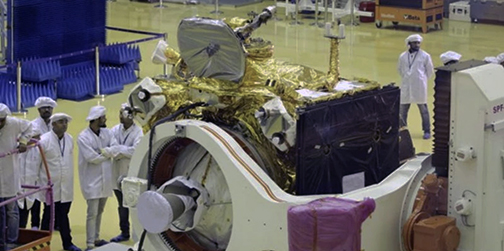
Photo of the ISRO's Chandrayaan 2 spacecraft.
India's second mission to the Moon, Chandrayaan-2, is scheduled to be launched on July 15, according to Indian Space Research Organisation (ISRO) Chairman K Sivan.
The launch will occur at 2:51 a.m. on board the GSLV MK-III vehicle from the Indian spaceport of Sriharikota.
The landing on the Moon near the South Pole — uncharted territory — is scheduled to occur on September 6 or 7, Sivan, as the ISRO is all set to embark on their most complex mission.
The original launch window had bee maintained by the from July 9 to July 16. The spacecraft, with a mass of 3.8 tons, has three modules — Orbiter, Lander (Vikram) and Rover (Pragyan). The Orbiter itself will have eight payloads, the Lander three and the Rover two.
The mission cost of Chandrayaan-2 with regard to the satellite was Rs 603 crore, Sivan noted. The cost of GSLV MK III is Rs 375 crore.
According to ISRO, Orbiter, with scientific payloads, will orbit around the Moon — the Lander would soft land on the Moon at a predetermined site and then deploy Rover. The scientific payloads on board Orbiter, Lander and Rover are expected to perform mineralogical and elemental studies of the lunar surface.
The Orbiter and Lander modules would be interfaced mechanically and stacked together as an integrated module and accommodated inside the GSLV MK-III launch vehicle. Rover is housed inside Lander.
After the launch into an Earth-bound orbit by GSLV MK-III, the integrated module would reach the Moon orbit using the orbiter propulsion module and, subsequently, Lander would then separate from Orbiter and soft land, close to lunar South Pole, the ISRO said. Rover will engage in scientific experiments on the lunar surface and instruments, also mounted on Lander and Orbiter, will also carry out scientific experiments.
Chandrayaan-2 is an advanced version of the previous Chandrayaan-1 mission, which was launched about 10 years ago. Chandrayaan-1 had 11 payloads — five from India, three from Europe, two from the U.S. and one from Bulgaria — and the mission is credited for discovering water on the lunar surface.

